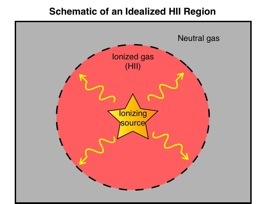

HII Region Basics
Introduction
Some of the most beautiful extended objects that we can see are HII regions, or diffuse or emission nebulae. So-named because they contain mostly ionized hydrogen (H+ or HII), HII regions are found throughout the interstellar medium in the Galaxy and in other galaxies.
As O and early B-type stars form and turn on within molecular clouds, their UV radiation begins to ionize the surrounding, mostly neutral hydrogen (HI) medium. The ionizing radiation from these stars or clusters of stars provide the ionizing source that powers the HII region throughout their stellar lifetimes. The evolution of HII regions from the time when stars turn on and the HII region first forms through its expansion over the stellar lifetime is the subject of this module.
Studying the evolution of HII regions
On the front page, you had the opportunity to look at a patch of sky and see a couple of HII regions in different wavelengths. What we see in our images are static HII regions. They haven’t always looked as we see them today, and nor will they stay this way forever. To determine the density, temperature, and other properties of HII regions, we can compare observations in different wavelengths and spectral lines. The ionization and recombination processes that take place for different elements in HII regions, as well as collisional excitations, cause HII regions to emit light in a variety of wavelengths. We can compare such observations to models of HII regions coupled to radiative transfer codes. In this module, we’ll go through a simplified mathematical formulation for the dynamical evolution of a pure hydrogen HII region. Our framework won’t explain the intricate features observed in images, but it will give us an idea of the basic underlying physics.